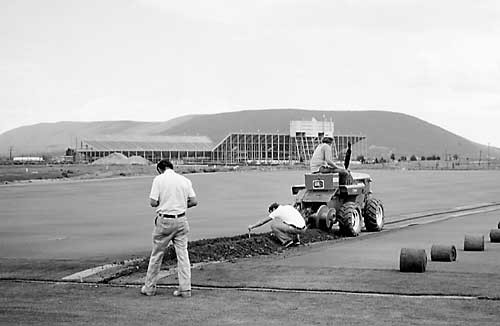Turfgrass Research and Facilities: #EXT100Years
May 11, 2014 in Articles
This post is the part of a series commemorating the 100-Year anniversary of the signing of the Smith-Lever Act which officially created the national Cooperative Extension Service.
Read More about the 100-year anniversary of Cooperative Extension.
Turfgrass Research and Facilities
From its modest beginnings in 1929, Penn State’s turfgrass research program has become one of the largest and best in the world. Research encompasses all aspects of turf management: breeding and selecting superior turfgrass varieties, developing improved techniques for establishing and maintaining turfgrass for various uses, and determining the environmental impact on variously maintained turfgrass areas. Research projects have been conducted in breeding and variety development; varietal identification techniques; species competition; growth regulation; weed, disease, and insect ecology; pest control; soil fertility; soil modification; and management.
It has been said that the sun never sets on a Penn State turfgrass variety. As a result of outstanding breeding research over the past seventy-five years, Penn turfgrass varieties are found all over the world.
From early turf research plots to a state-of-the-art classroom building and a vision for a new and consolidated research center, Penn State’s turfgrass facilities are continually evolving to support the program’s research and educational activities.
In the 1940s and 50s, the turf research plots had many homes around campus. “They moved around a lot,” says Tom Watschke. “They used to be at the current site of East Halls, then where the Natatorium is. Jim Watson and Jack Harper did their Ph.D. field studies on a piece of land where the computer center is now.” When the plots were chased away by building construction again in the late 1950s, they were moved to their current location, the Joseph Valentine Turfgrass Research Center.
Joseph Duich, who oversaw the Valentine Center’s development, remembers its beginnings. “First of all, we had to go where there was water. We looked at a university map for locations with water lines, and once the location was chosen, we started from scratch. Two technicians, Russell Smith and Herb Zimmers, and I developed the land, and it was a lot of work. We planted our first grass in 1959.”
